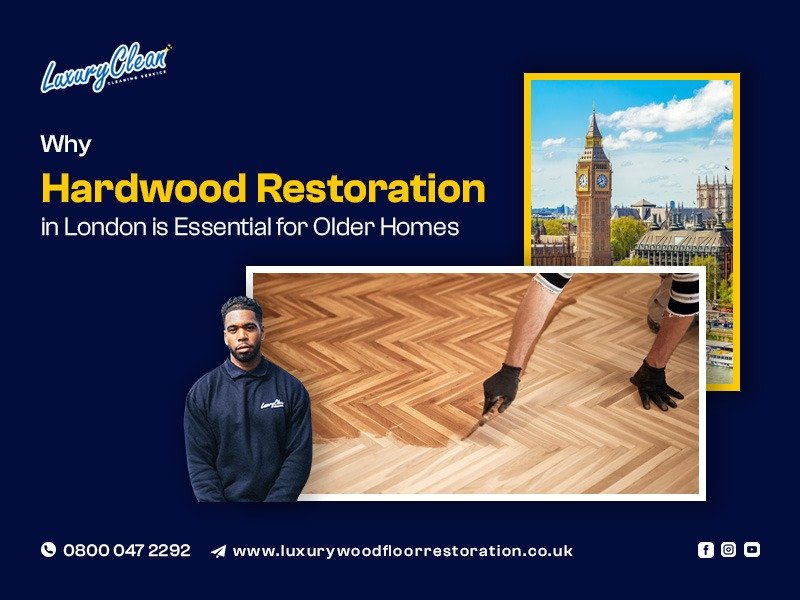London’s older homes are architectural time capsules, but their charm often hides a silent struggle: worn-out hardwood floors. Damp winters, centuries of footfall, and modern lifestyles take a toll. Wood floor restoration isn’t just about aesthetics—it’s a lifeline for preserving history, boosting value, and ensuring these spaces thrive for generations. Let’s explore why this process is non-negotiable for London homeowners.
1. London’s Climate Demands Specialised Care
London is known for its damp climate. The wide range of humidity between wet winter and hot summer months makes wood floors expand and contract and eventually warp. Damp-proofing systems from Victorian and Georgian terraced homes before modern standards were introduced have caused the situation to deteriorate. Floorboards suffer from rot or mould development when moisture penetrates without appropriate maintenance measures which creates problems for building structure and human health.
- Dampness & Decay: A 2022 report highlighted that 34% of London’s listed homes face moisture-related decay, emphasising the urgency of restoration to prevent irreversible damage.
- Seasonal Shifts: The city’s temperature swings make floorboards “breathe,” requiring adaptive restoration techniques to avoid cracking.
- Mold Prevention: Properly sealed floors block moisture infiltration, aligning with guidelines from conservation experts.
2. Preserving Architectural Heritage
London’s older homes are cultural landmarks. From the parquet of Notting Hill townhouses to the wide-plank floors of Kensington manors, these surfaces tell stories. Hardwood screening—a process of smoothing scratches without stripping wood—helps retain original materials while refreshing their look. Over-sanding, common in rushed jobs, can erase historic patina, a mistake as irreversible as painting over a Constable.
- Original Craftsmanship: Many floors feature rare timbers like pitch pine or oak, now cost-prohibitive to replace.
- Eco-Impact: Restoring floors cuts waste—critical in a city aiming for net-zero by 2030.
- Cultural Value: Floors in Hampstead’s historic pubs or Bloomsbury’s literary haunts are as iconic as their facades.
3. Boosting Property Value the London Way
In a competitive market like London’s, restored floors are a selling point. Buyers crave authenticity but demand modern durability—wood floor restoration bridges that gap.
- Regulatory Compliance: Listed building owners face fines for unauthorised replacements—restoration keeps councils happy.
- Rental Appeal: Restored floors enhance the charm of homes in areas like Camden, attracting short-term renters.
- Cost Efficiency: Restoration avoids the logistical hurdles of sourcing rare timber replacements.
4. The Science of Hardwood Sanding
Hardwood sanding isn’t just about smoothing surfaces—it’s a precision craft. London’s older floors often have uneven wear from decades of use. Sanding evens them out but must be done carefully to avoid thinning boards.
- Dust-Free Tech: Modern tools minimise airborne particles, crucial in London’s dense neighborhoods.
- Stain & Finish: Matte finishes hide scratches from bustling family life, a trend noted in conservation guidelines.
- Noise Regulations: Sanding in residential zones often requires permits—a detail professionals handle seamlessly.
5. A Stitch in Time: Preventing Costly Repairs
Ignoring floor issues compounds costs. A small scratch becomes a splintered plank; a damp patch turns into structural rot. Regular upkeep—part of London’s “preventative maintenance” culture—saves thousands.
- Spot Checks: Discolouration near windows or fireplaces signals moisture intrusion, per damp diagnosis protocols.
- Quick Fixes: Fill gaps with wood slivers to maintain breathability, as recommended by conservationists.
- Rug Rotation: High-traffic areas like entryways benefit from rotating rugs to distribute wear.
Conclusion
Restoring hardwood floors in London’s older homes is more than home improvement—it’s stewardship. By addressing climate challenges, honoring history, and investing in quality, homeowners safeguard their spaces’ legacy. Whether you’re in a Georgian terrace or a converted warehouse, remember: the floors underfoot are the foundation of your home’s story. Ready to give yours the care it deserves?

